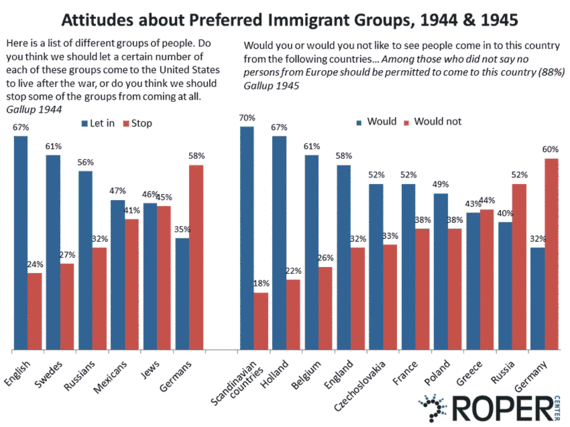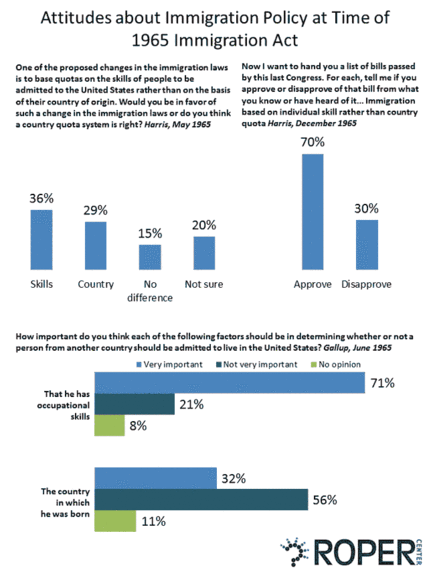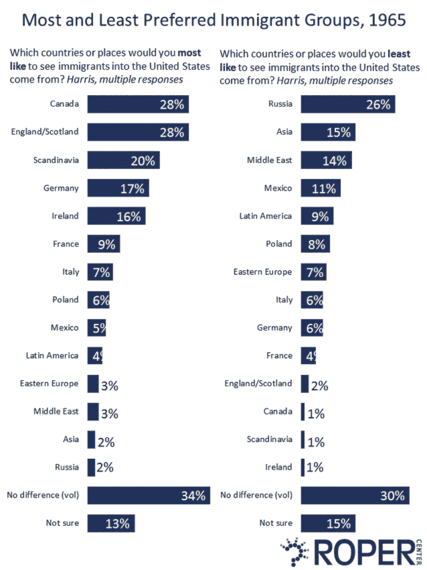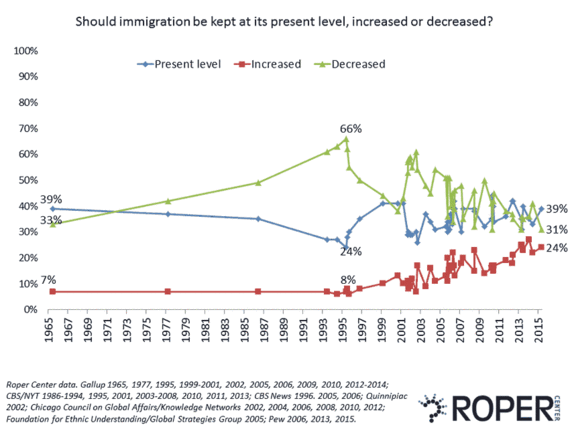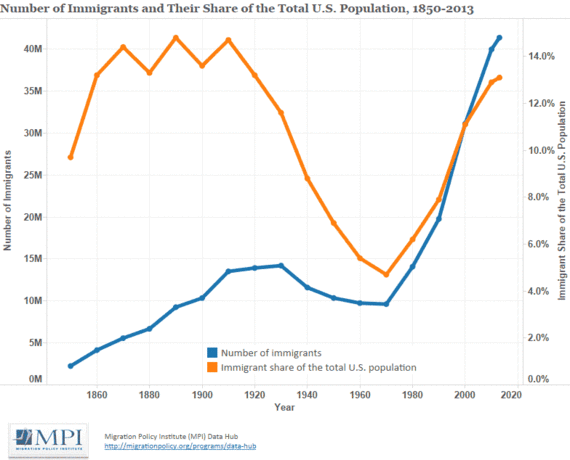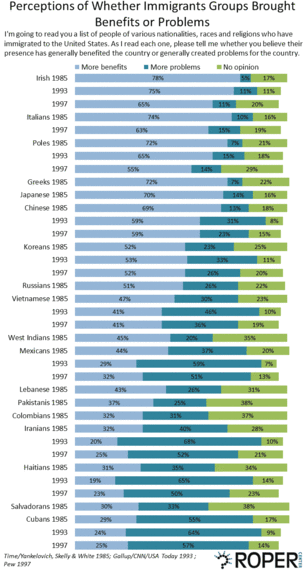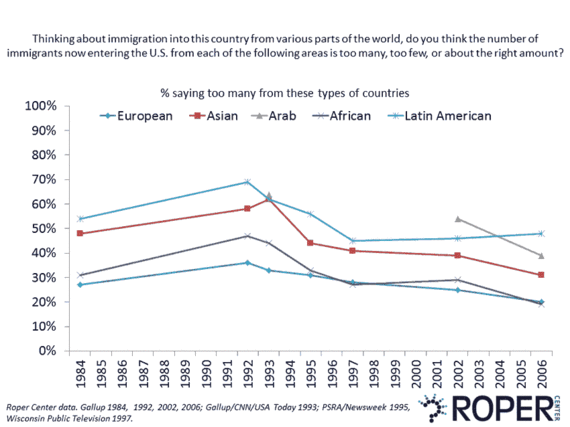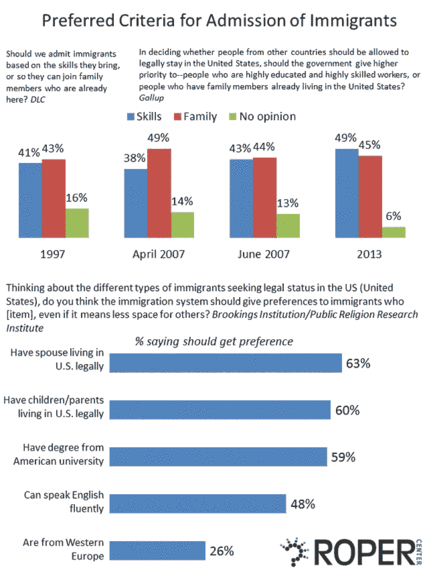The landmark U.S. Immigration and Nationality Act of 1965, which shifted the criteria for admission of immigrants from a system of country quotas to the prioritization of family reunification and occupational skills, is now fifty years old. Public opinion polls from before, during, and after the 1965 debate reveal ongoing concerns about how the country chooses which immigrants become Americans and how different immigrant groups affect the nation. From the Roper Center for Public Opinion research archives: Attitudes about Immigration before 1965 Questions about concerns regarding the ethnic makeup of immigrants to the United States were asked from the very earliest days of polling. When asked in 1939 by Roper/Fortune which nationality of people in the US originally born in a foreign country made the “worst” citizens, a majority (55%) to their credit said they didn’t know. A plurality of those who gave an answer said Italians (22%), with Jews (6%) and Germans (4%) far behind. In 1944, most Americans were willing to welcome some immigrants from England, Sweden and Russians, but lower proportions wanted to see Mexicans and Jews allowed to come to the U.S., and a majority did not want Germans to come. Just a year later, more than half of those willing to see any immigration from Europe (88%) said they would not want to see people come to this country from Germany or Russia, while strong majorities expressed a willingness to welcome immigrants from Scandinavian countries or Holland. These preferences stood much in line with the pro-Northern European structure of the National Origins quota system, with the addition of anti-German feeling from the War. U.S. Immigration and Nationality Act of 1965 Everywhere else in our national life, we have eliminated discrimination based on one’s place of birth. Yet this system is still the foundation of our immigration law. Robert F. Kennedy, 1964 The system Kennedy described was not to last much longer, and the major changes at hand came with high public support. A strong majority approved of the bill passed by Congress to base immigration on skills rather than country quotas. Over seven in ten said that occupational skills were very important in determining whether he should be admitted to live in the United States, while only about a third said the same about country of origin. While the public may have believed that country of origin should not form the basis for immigration policies, most Americans still felt that some immigrant groups were preferable to others. At the time of the bill’s passing, a Harris poll asked Americans about most and least preferred nationalities for new immigrants. Roughly a third of respondents said that there was no difference, and about another one in seven had no opinion. Among those who answered the question, Canada, England/Scotland and Scandinavia topped the list of most preferred, while the immigrant groups whom Americans would like to see the least were Russians, Asians, and Middle Easterners. Census data from 1960 showed that immigrants from Italy made up the largest share of newcomers from a single country at 12.9% of the immigrant population, followed by Germany (10.2%), Canada (9.8%), UK (8.6%), Poland (7.7%), and the Soviet Union (7.7%). Europeans made up 74.5% of the immigrant population, while immigrants from the Americas (including Canada) were 19.1%. Therefore, at the time of this policy shift, Americans’ preferences for the geographical mix of immigrant groups were largely in line with the actual immigrant population, with the exception of relatively high proportions of Russians and Italians. It was in 1965 that pollsters first began asking what was to become a fifty-year trend question about whether immigration should be kept at its present level, increased or decreased. In the first poll, about a third of the country thought immigration should be decreased, while nearly four in ten said it should be kept at the present level. The proportion wanting a decrease in immigration reached a peak of 66% in 1995, and then fell off quickly, only to rise again in the early 2000s, particularly following 9/11. Since 2002, the proportion saying they want immigration decreased has been in an uneven decline, reaching a low of 31% in the latest poll, while those saying they want to see immigration increased has reached nearly a quarter. Americans’ desire to see lower levels of immigration increased as the rate of immigration rose following the 1965 Immigration Act. However, the falloff since 1995 in the proportion of Americans saying that immigration should be decreased has occurred while immigration numbers have continued to rise, with the immigrant share of the US population reaching levels not seen since the 1920s. The 1965 Act did not simply increase the level of immigration; it also changed the ethnic makeup of the immigrant population. As a result, new ethnic groups became the focus of public concern. When asked in 1985 whether people of particular nationalities had brought more benefits or problems for the country, strong majorities said more benefits than problems had been brought by Italians, Poles, Japanese and Chinese, all groups who had at one point in the history of immigration debate been seen as undesirable by large portions of the population. When the question was re-asked in 1997, near the peak of the proportion of Americans saying the level of immigration should be decreased, nearly every group received more negative ratings, including such positively viewed ethnicities as the Irish, Italians, and Poles. Going into the new century, Americans continued to view immigration from some parts of the world more positively than others. Changes in perceptions of whether there are too many immigrants from each part of the world have generally moved in tandem, with little change in the respective levels of support. Immigration Today The idea of prioritizing immigration based on national origin, once the foundation of U.S. immigration policy, has fallen so far from favor pollsters have rarely addressed it. In the last such question in 2013, only 26% of Americans thought immigrants from Western Europe should get preference over other immigrants. Date Published: July 10, 2015 |
Huddled Masses: Public Opinion & the 1965 U.S. Immigration Act

